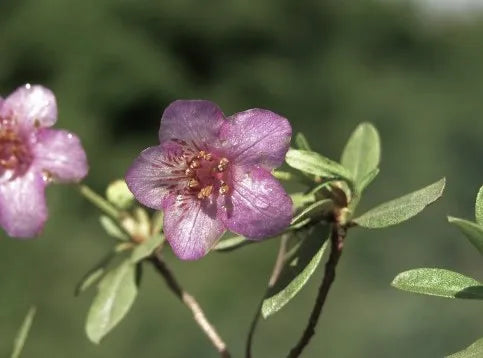What is Grayanotoxin?
Grayanotoxins are a group of neurotoxins found in plants like certain Rhododendron species and Leucothoe grayana. These toxins can also be present in honey made from the nectar of these plants, commonly known as "mad honey." In Nepal and Turkey, this honey has been used both for medicinal purposes and as a recreational substance because of its effects.
The Rhododendron family includes over 750 species, many of which contain grayanotoxins (GTXs). These toxins are present in the plant's green parts, nectar, flowers, and pollen.
In Turkey, five species of rhododendrons are present, especially R. ponticum (purple flowers) and R. luteum (yellow flowers), growing from sea level up to altitudes of 3,200 meters.
Which Rhododendron Nectar Contains Grayanotoxin?

Rhododendron Arboreum
The bright red rhododendron flower or “lali gurans” in Nepali is a small tree widely popular in Nepal as the national flower. The flowers that grow both in low and highlands has the apt amount of grayanotoxin–a source for the recreational properties in the honey.

Rhododendron Campanulatum
Slightly pinkish and bell-shaped, rhododendron campanulatum originates from the Himalayas and Tibet. The flowering plant belongs to the family Ericaceae and has a content of grayanotoxin in it.

Rhododendron Barbatum
This species has bright red flowers and is usually found in the temperate regions of Nepal. The nectar from Rhododendron barbatum also adds to the psychoactive effects of Mad Honey.

Rhododendron Lepidotum
Also known as "Sunpati," it has small pinkish-white or pale yellow fragrant flowers. It grows in the subalpine regions of Nepal and is a source of Grayanotoxins in honey.

Rhododendron Anthopogon
Found at higher altitudes, it has small white to pale pink flowers and is locally used in traditional lmedicine. The nectar from Rhododendron anthopogon contains Grayanotoxins that bring out the best in the honey.

Rhododendron Luteum
Known for its beauty, yellow azalea or honeysuckle azalea also contains grayanotoxins—natural compounds that give certain honeys, like mad honey, their unique and potent effects.

Rhododendron Ponticum
A lavender-colored flowering plant in the Rhododendron genus of the Ericaceae family produces the rare, reddish-brown honey known as mad honey. Found only in limited regions, this honey owes its fame to the plant’s grayanotoxin content.
Current Research and Studies
on Grayanotoxin Toxicology
Ongoing research on grayanotoxins mainly focuses on the effects of the toxin on the human body. There exist numerous studies that show how grayanotoxins can alter the mind and body. Researchers showcase how the dosages that an individual can take varyingly affect him.
Several studies differentiate the several types of grayanotoxins and their respective symptoms. Understanding the mechanism of how grayanotoxin works, and how there are various forms of grayanotoxins may reduce the negative image that the neurotoxin carries.
Ethnobotanists are documenting these practices, aiming to guide safer modern use in accordance to the current scenario. Whereas, public health research is working to improve the diagnosis and treatment of wild honey poisoning and develop guidelines to protect consumers.
Environmental and agricultural research shows how factors like altitude and climate influence the concentration of grayanotoxins in Rhododendron plants, as well as how these toxins affect bee populations.
Grayanotoxin I (GTX I)
Grayanotoxin I (GTX I) is a crucial neurotoxin in the leaves of Rhododen-dron flowers that acts as a shield for insect and vertebrate herbivores. Grayanotoxin I (GTX I) is present in the nectar of various Rhododendron species, with a phenotypic correlation between GTX I concentrations in leaves and nectar, showing high interspecific variation and significantly higher concentrations in leaves compared to nectar or petals.
Grayanotoxin II (GTX II)
Grayanotoxin II reduces the natural rhythm of the sinoatrial node by alteri-ng the cell membrane’s permeability to sodium ions and is considered the least toxic form of all grayanotoxins. It requires larger doses to produce si-milar effects, resulting in milder symptoms that develop more slowly and have temporary effects.
Grayanotoxin III (GTX III)
Ten samples of a special type of honey called "mad honey" from Turkey we-re tested to measure the amount of a compound called GTX-III, which can cause poisoning. GTX-III works by blocking sodium channels in the cell membrane, which affects how cells function. The concentration of GTX-III in these honey samples ranged from very low (0.701 µg/g) to high (68.754 µg/g), with the highest amount found in a sample from Artvin/Hopa (MH7), an area already known for causing grayanotoxin poisoning.
Toxicity In Traditional Medicine
Most cases of mad honey intoxication occur in men aged 40 to 60, often due to its use as a sexual stimulant or for managing hypertension. Consuming 15 to 30 grams of the rare honey can cause intoxication, with symptoms appearing within 30 minutes to 4 hours.
Men are five times more likely than women to experience honey poisoning. However, with long-term use, the body may become desensitized, reducing the severity of symptoms over time.
A study on rats showed that high doses of mad honey could slow heart rate and breathing, while lower doses did not cause these effects. Interestingly, rats with their vagus nerve cut did not experience this heart-slowing effect, indicating that grayanotoxins affect the heart and breathing through the central nervous system, specifically by stimulating the vagus nerve.
Additionally, research has shown that it can have hallucinogenic effects at higher doses, which can lead to anxiety and mental confusion. However, when consumed in small, recommended doses, these effects are much milder and more manageable.
Grayanotoxin Poisoning Symptom
Unlike what the media says, grayanotoxin can be an effective ally to your mind, relaxing your nerves and putting you in the right mood. However, moderation applies to everything, even to the greatest things in mankind.
The moment that you let go of the guidelines and overindulge in grayanotoxin, you are going to backfire your health. Grayanotoxins in high amounts can be ridiculously dangerous. You will likely experience symptoms that are mild to high. The result depends on your consumed amount.
In a milder form, there are symptoms like dizziness, and weakness. One level up, sweating, vomiting, tingling sensations, blurred visions, and low blood pressure(hypotension) will follow. In rare cases, consumers face fainting and seizures. Cardiac issues may also arise, including slow heart rate, nodal rhythms, complete heart block, and low blood pressure. Occasionally, transient conduction abnormalities like a Wolff-Parkinson-White pattern are seen.
Symptoms typically begin within 30 minutes to 3 hours, most commonly in 1 to 2 hours. Treatment is possible, with fluids and atropine often used to address hypotension and bradycardia.
Gryanotoxin Poisioning Studies, Effects, and Disease
Grayanotoxins mainly target voltage-gated sodium channels in neurons, particularly affecting the central nervous system. Animal studies have shown that grayanotoxins cause bradycardia and respiratory depression, with the toxin’s effects moderated by muscarinic receptors in the heart. Studies on rats have demonstrated that atropine can reverse these effects.
The most well-documented cases of grayanotoxin toxicity are classified as mad honey disease, resulting from the ingestion of honey containing grayanotoxins. Patients typically consume between 20–200 grams of this honey. Contamination occurs mainly in the eastern Black Sea region of Turkey, where bees collect nectar from Rhododendron ponticum and Rhododendron luteum. Due to the small-scale nature of local beekeeping, honey is often produced from a single hive or small area, leading to higher grayanotoxin concentrations.
In areas with large-scale production, mad honey from multiple sources is blended, reducing the risk of severe contamination. However, some beekeepers intentionally produce mad honey for its supposed medicinal benefits.
Though mad honey is the most common source of grayanotoxin poisoning, ingestion of the leaves, nectar, or flowers of Ericaceae plants can also cause toxicity in humans and animals. Current toxicology research focuses on understanding the varied effects of different grayanotoxin types, the environmental factors influencing plant toxin concentration, and potential medicinal uses at lower, controlled doses.
Grayanotoxin
Intoxication in Animals
Grayanotoxin intoxication in animals, particularly cattle, is more common than in humans and has also been reported in sheep, goats, and donkeys. Plants like Rhododendron, Kalmia (laurel), and Pieris are known sources of grayanotoxin poisoning in animals. Rhododendron intoxication is most frequent in winter and early spring, as its leaves are perennial.
The toxic dose is 0.2% of body weight for cattle and 0.4% for Kalmia. Symptoms, including gastrointestinal irritation, cardiac arrhythmias, and neurological issues, appear 3–14 hours after ingestion and last about two days. Though recovery is possible, intoxication often proves fatal in animals, with aspiration of vomit being a common cause of death by Mad Honey. Despite awareness of the risks, poisoning can still occur when animals are unintentionally fed toxic plants, as in cases of goats eating Pieris japonica or Rhododendron indica branches provided by bystanders.



